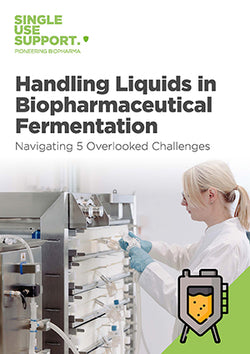Microbial Fermentation simply explained
Microbial fermentation is a biochemical process that manages to extract chemical energy from carbohydrates without the oxygen. This chemical reaction occurs in bacteria, yeasts or even in muscles of humans.
More than ten thousand years ago, humans began to use microbial fermentation to refine and preserve food. Ethanol fermentation then led to the brewing of beer and wine.
Millennia later, scientists found ways to reprogram bacteria and yeasts to produce their desired products with pharmaceutical fermentation. This approach to biopharmaceutical production seems to be a worthwhile undertaking, as it is much more efficient than culturing of animal cells.
This article will give our readers a thorough look at what microbial fermentation is, how it works, and which products can be produced by this process.
Pharmaceutical fermentation: complete guide
What is microbial fermentation?
Microbial fermentation is the breakdown of nutrients, mostly sugars and carbohydrates, by metabolic enzymes from microbes in the absence of oxygen. Generally, many types of microorganisms are present during the fermentation process and each of them has a distinct set of enzymes, leading to the formation of complex mixtures byproducts that characterize the smell and taste of fermented foods.
Probably the best-known examples of food products that are produced by fermentation are alcoholic beverages like beer and wine. Yeasts belonging to saccharomyces cerevisiae use glucose and related sugars as substrates in their biochemical processes to yield ethanol and carbon dioxide as end products.

Another common instance of food fermentation products are kimchi, kefir and sauerkraut. Their production relies on lactic acid bacteria that produce lactic acid as an end product. The released acid has the crucial effect of rendering the fermenting food uninhabitable for other microorganisms that would lead to spoilage, thus greatly increasing the shelf life of fermented foods.
Fermentation is a big topic in the food industry and has a long history in the preparation of our food - but we at Single Use Support are dedicated to fermentation mainly because of the great potentials in the production of novel drugs and therapies. [[1]]
How does microbial fermentation work?
In general, microbial fermentation occurs to some extent in every biomass. It is a key bioprocess to devide complex biomolecules into simpler building blocks while releasing chemical energy and returning it into the environment for the next cycles of building complex organic matter by higher organisms like plants and animals.
In terms of biochemistry, microbial fermentation uses enzymatic processes that digest carbohydrates and use it as a source for ATP (Adenosine triphosphate), the universal energy currency in all organisms, without the use of oxygen (i. e. anaerobically).
3 forms of microbial fermentation
Three basic forms of microbial fermentation are known in microbiology:
Lactic acid fermentation
Lactobacillus species use sugars, carbohydrates and starches to extract energy and produce lactic acid. It is very common in food production: dairy products like yogurt and related probiotics. In the pharmaceutical industry, lactic acid is used in implants, pills, dialysis, surgical sutures, and controlled drug release systems. In the cosmetic industry, lactic acid is used in the manufacture of hygiene and aesthetic products because of its moisturizing, antimicrobial, and rejuvenating effects on the skin.
Ethanol fermentation
Yeasts digest sugars to produce ethanol and carbon dioxide. Such yeasts are commonly used in breweries, wine-making and bakeries. Pharmaceutical ethanol fermentation is used as a solvent to dissolve the active ingredient in some medicines, or as an extraction solvent in herbal medicinal products. Ethanol has also been used as an antimicrobial preservative, possessing bactericidal and fungicidal activity.
Acetic acid fermentation
Sugars are converted into acetic, propionic and butyric acids and other flavorings, which give vinegar the complex sour taste. In medicine, acetic fermentation has antiseptic properties that are used to cure bacterial infections.
Of course, the characterization of the involved microorganisms has led to the development of biotechnology tools to harness them for scale-up in bioreactors to secure the large supply demands.
Where does microbial fermentation occur?
Fermentation is a general biochemical tool for energy generation during times of scarce oxygen supply. Even in human bodies, fermentation processes occur in muscles when energy is needed more quickly than oxygen can be transported to the tissue - picture sprinters or weightlifters who produce huge power outputs in short amounts of time.
Interestingly, microbial fermentation occurs in animals as well: in their gastrointestinal tracts. Microorganisms feed on digested food and help our bodies break it down to valuable building blocks. Herbivores couldn’t extract enough energy from their plant-based nutrition without the help of methane-releasing microbes.
Microbial fermentation and its industrial applications
Nowadays, the industrial applications of microbial fermentation have become wide-ranging and numerous. With the development of recombinant techniques, fermentation technology underwent revolutionary changes and the fields of applications broadened.
Traditionally, the food industry was the biggest benefactor of fermentation. Essential foods like cheese are based on microbes in order to become better digestible. Alcoholic beverages like beer, wine, and cider would not exist without fermentation.
Over time, innovations led to the development of processes to produce pharmaceuticals and use microbial cultures as tools for basic research.
Importantly, fermentation of plant matter to produce fuels such as bio-ethanol might become a way to get closer to energy-sustainability and move from petrol as an energy source.
Microbial cGMP production: guide & manufacturer's overview
We find fermentation much more often than just in the food industry
While fermentation is prevalent in the food industry to refine the taste of cabbage, vegetables, soybeans and many more, the process is also important to increase the shelf life of foods without cooling. Cooking as an alternative measure to prolong the shelf life might destroy nutrients like antioxidants. Therefore, fermented foods are basic foods for many ancient cultures, as they allow the long-term storage and transportation of nutritious foods without having to take care of cooling measures.
Moreover, a completely different field of application for fermentation is the pharma sector. Microbes are great at chemical synthesis of complex natural products and have become important tools for the manufacturing of medicines.
Fermentation in biopharma
With deeper insights into life sciences and chemical synthesis, microbes became a key instrument to produce secondary metabolites such as penicillin (which can be considered precision fermentation). Moreover, molecules that are chemically closely related to complicated final products with health benefits and medical uses can be manufactured by fermentation and finalized by in vitro methods (e. g. macrolide antibiotics).
Since the advent of recombinant technologies, the genomes of microbial host organisms can be reprogrammed and undergo optimization to produce peptides, proteins, fatty acids, lipids and even highly complex antibodies. The applications are manifold: from supplements to split lactose into digestible carbohydrates for lactose-intolerant persons (lactase capsules) to individualized medicines against cancer (antibody drug conjugates).
Read more about fermentation in the pharmaceutical industry or microbial fermentation manufacturing.

[[download-1]]
History of microbial fermentation
Naturally, microbial fermentation as a process predates humans by at least a billion years. The history of fermentation starts at least 12,000 years ago. Humans learned to use microbial fermentation with the advent of the first human civilizations in the middle east. The main use was preservation of foods, probably lactic acid fermentation.
The Egyptians and Sumerians began to produce beer, wine and bread about 7.000 years ago. The processes and recipes were refined for thousands of years without any non-religious understanding of what exactly happened during fermentation.
The scientific explanation of fermentation was proposed in the 19th century by Louis Pasteur, the discoverer of microorganisms like bacteria and yeasts. He elucidated that different organisms gave rise to different end products.
Pasteur's insights now enable mankind to further refine fermentation processes and the way to innovations in what we call biotechnology nowadays.

Microbial Fermentation Outlook
Microbial fermentation continues to be a major growth area, especially in the biopharmaceutical industry. Demand for smaller, complex, novel molecules, such as bioconjugates like antibody-drug conjugates (ADCs) or antibody fragments, is driving demand for microbial fermentation in the pharmaceutical industry. Although the use of recombinant technology with mammalian cell culture became very popular to manufacture highly complex biopharmaceuticals, this approach is too overpowered for many high-volume bioproducts.
Less complex proteins and secondary metabolites do not require the biochemical machinery of mammalian cells, e.g. post-translational modifications. Hence, the use of tailored yeasts or bacteria is a viable alternative for these products. Their cultures are easier scaled-up and their growth in big bioreactors is relatively facile and inexpensive. Such processes prove much more energy-conservative and sustainable than their mammalian counterparts.
Read more about the difference between microbial fermentation and mammalian cell culture.
Single Use Support supports the renaissance of fermentation in bioproduct manufacturing and offers end-to-end processes in fluid management and freeze-thaw logistics for these sustainable and measured approaches.
Single Use Support offers solutions for recurring challenges in biopharmaceutical manufacturing in general, and their expertise directly translates from Cell and Gene Therapies to the microbial fermentation sector. Many production processes face the same difficulties and share common solutions, which Single Use Support specializes in.
References

Download guide
Guide: Challenges in biopharmaceutical fermentation
Guide about microbial or mammalian fermentation with regards to fluid and cold chain management challenges. In detail:
- Advanced Bulk Plate Freezing replacing Spray Drying
- Protection of Bags Reduce Product Loss
- Scalability in Yeast, Bacterial or Fungal Fermentation
- Speed of Large Volume Filling and Freezing
- Integrated End-to-End Logistics in Continuous Production
Learn more to navigate 5 of these most overlooked challenges in this Fermentation Guide.
